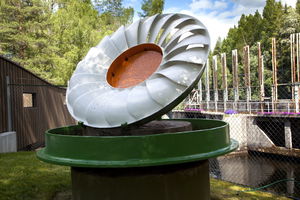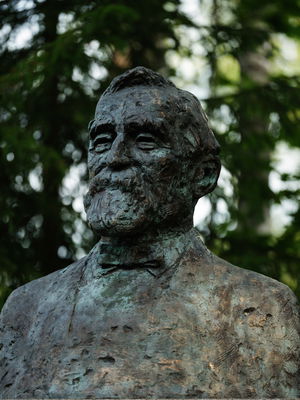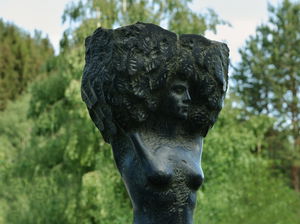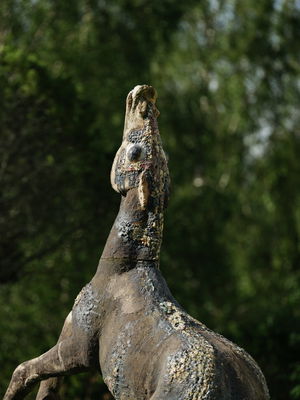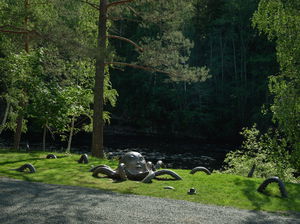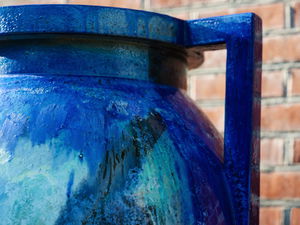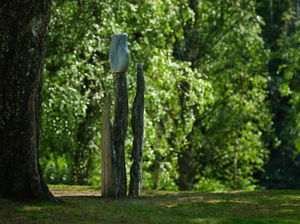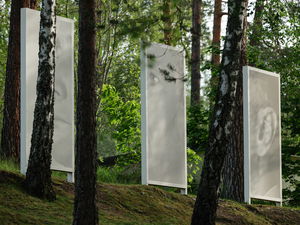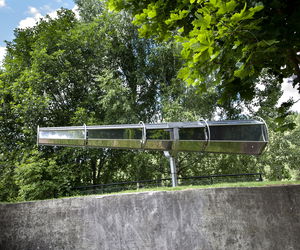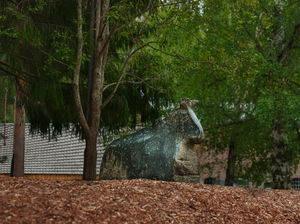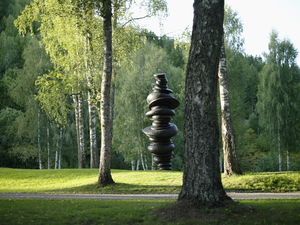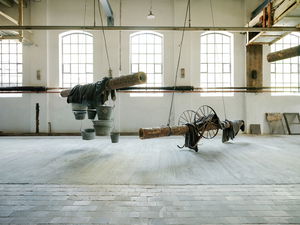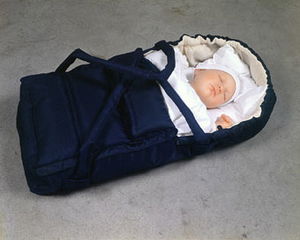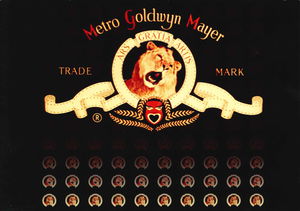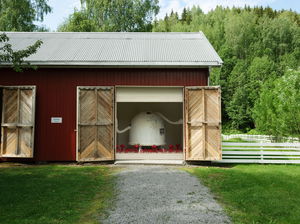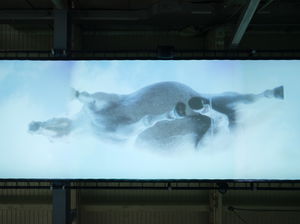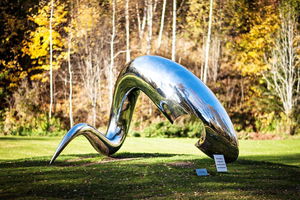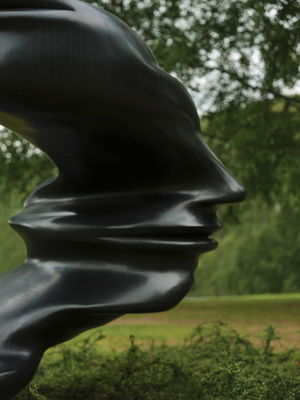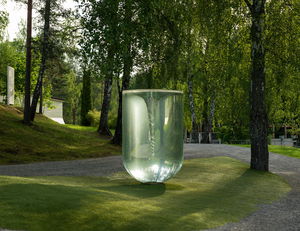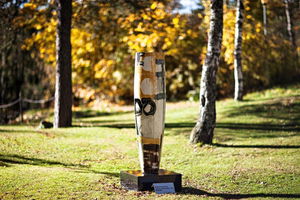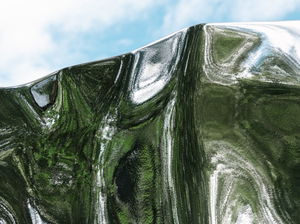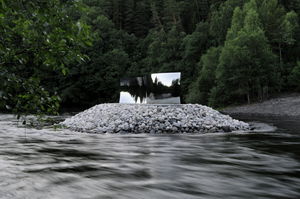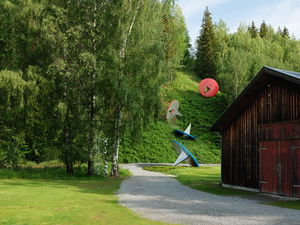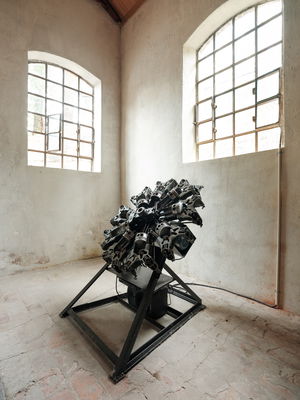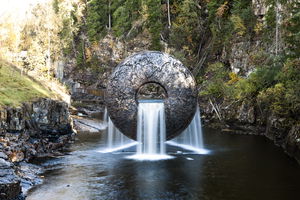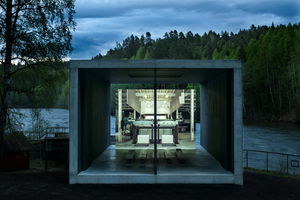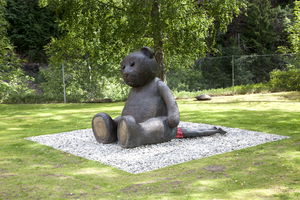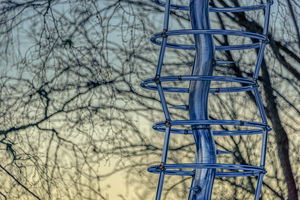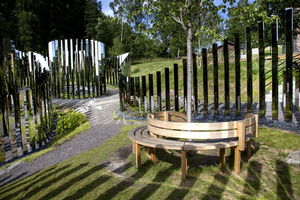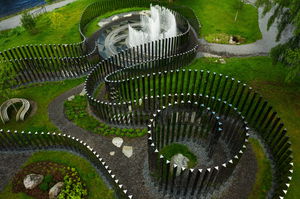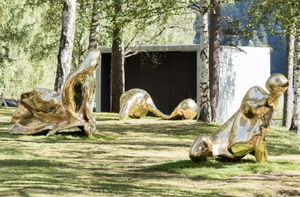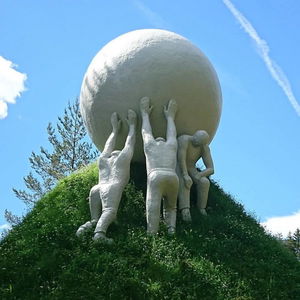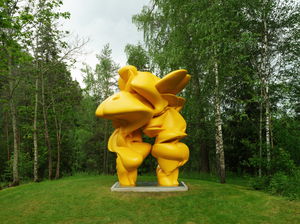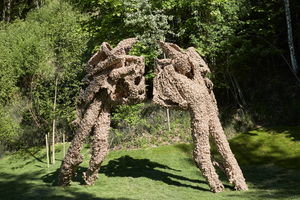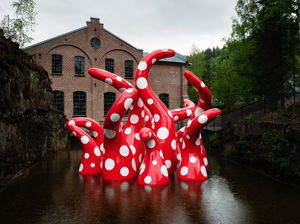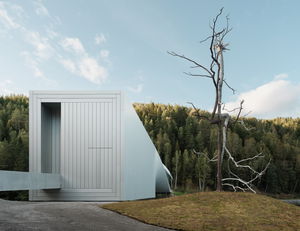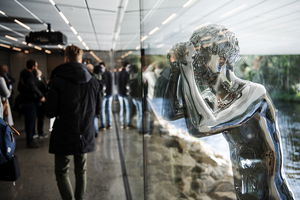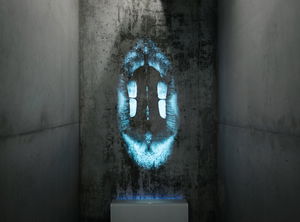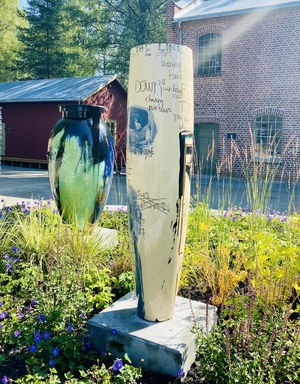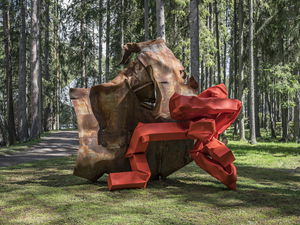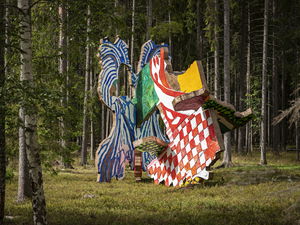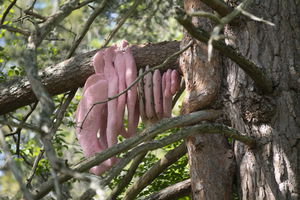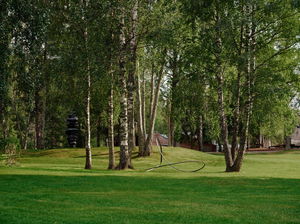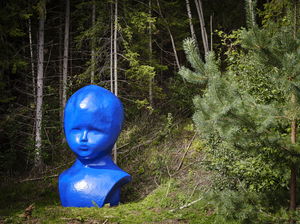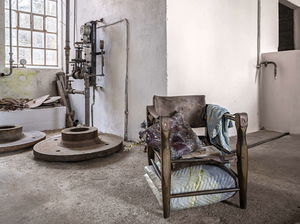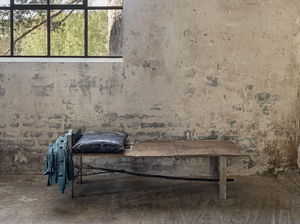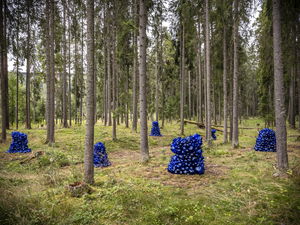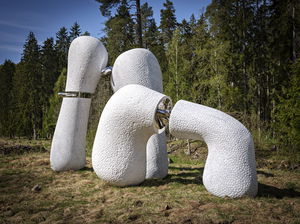“Mounts of the Samurai The Third Day”
by Siri Bjerke

Mounts of the Samurai The Third Day by Siri Bjerke. Photo: Einar Aslaksen.
Mounts of the Samurai The Third Day
- Unveiled 2003
- Materials Larvikite
- Dimensions 135 cm
- Artist Siri Bjerke
- Where Show on map
Mounts of the Samurai The Third Day is made of granite, which has been partly polished and partly rough-hewn. The partially unprocessed surface helps to challenge the public’s perception of how a ”finished” sculpture should look. The sculpture depicts a moose and it looks as though the animal is undergoing a metamorphosis: It is on its way to burst up and out of the stone.
The sculpture requires respect for the material’s own quality and substance while the figure advances from the material, in order for us to see what the stone is supposed to portray. The stone can speak its own language. Simultaneously, a few traits point to the animal’s reality.
The artworks of Bjerke, especially Mounts of the Samurai The Third Day are strongly inspired by fairytales, stories and myths. The meaning presupposes recognition of the imitated, but the imitation must surrender to contemplation and obedience to the new that breaks with the traditional.
The size and shape of the sculpture welcomes physical contact. Children are an important audience for Bjerke: She wants them to get inspired to fantasize. To freely act out their own stories associated with animal motifs and to ”want to get on it and ride into an exciting and unknown wonderland”.

Mounts of the Samurai The Third Day by Siri Bjerke. Photo: Einar Aslaksen.
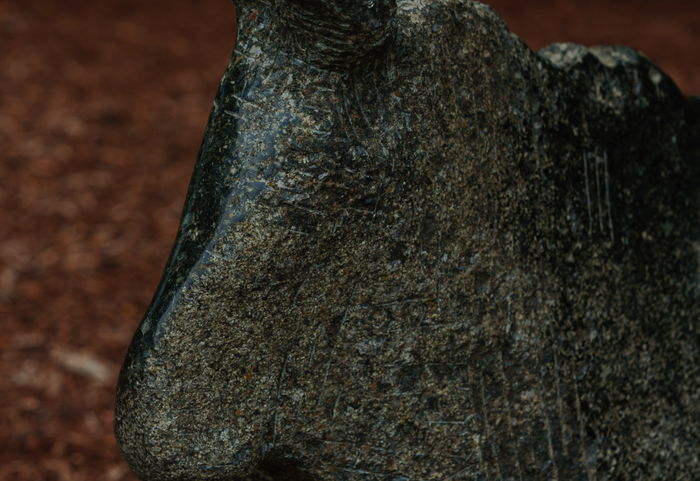
Detalj from Mounts of the Samurai The Third Day by Siri Bjerke. Photo: Einar Aslaksen.
-
01 Ståle Kyllingstad, Installation
-
02 Nils Aas, Consul Anders Sveaas, 1840-1917
-
03 Nico Widerberg, Time
-
04 Beate Juell, Stallion
-
05 Kristian Blystad, Playing horse
-
06 Bjarne Melgaard, Octopus
-
07 Kjell Nupen, Stille, Stille/Mediteraneo
-
08 Kjell Nupen, Mediteraneo
-
09 Edgar Ballo, Blå tulipan
-
10 Anne-Karin Furunes, Christen Sveaas
-
11 Olafur Eliasson, Viewing machine
-
12 Siri Bjerke, Mounts of the Samurai The Third Day
-
13 Fernando Botero, Female Torso
-
14 Tony Cragg, Articulated Column

The energy and shape of the sculpture easily give associations to the surrounding natural landscape, especially the water and the waterfall's fierce power/energy.
-
15 Fabrizio Plessi, Movimenti della Memoria

This installation is placed inside the Wood Pulp Mill
-
16 Elmgreen og Dragset, Forgotten Babies # 2
-
17 Marianne Heske, Homage to Leo the Lion

The sculpture is placed inside the Wood Pulp Mill
-
18 Shintaro Miyake, Welcome to our Planet
-
19 Kristin Günther, Hesten

The sculpture is placed inside the Wood Pulp Mill
-
20 Tony Cragg, I'm Alive

This sculpture, with the fitting title I’m Alive, at first glance looks like a powerful creature meandering forward.
-
21 Tony Cragg, Bent of mind

Bent of Mind looks as though it is constantly growing and changing. The two profiles, which make up the sculpture’s main motive, constantly change character as you move around the sculpture to see them from different angles.
-
22 Petroc Sesti, Energy-Matter-Space-Time
-
23 Magne Furuholmen, Hypnos Descending
-
24 Elmgreen og Dragset, Warm Regards
-
25 Anish Kapoor, S-Curve
-
26 Oldenburg og van Bruggen, Tumbling Tacks
-
27 Thomas Bayrle, Sternmotor Hochamt

You´ll find Sternmotor Hochamt inside the Furnace House, just outside The Wood Pulp Mill
-
28 Marc Quinn, All of Nature Flows Through Us
-
29 John Gerrard, Pulp Press (Kistefos)
-
30 Fredrik Raddum, Teddy - Beast of the Hedonic Treadmill
-
31 Fredrik Raddum, Catastrophic road Signs, Sun
-
32 Per Inge Bjørlo, Slektstrea, Genbanken
-
33 Phillip King, Free to Frolic
-
34 Jeppe Hein, Modified Social Benches Kistefos
-
35 Jeppe Hein, The Path to Silence
-
36 A Kassen, River Man

River Man by the artistic collective A Kassen took form as liquid bronze was poured directly into the waters of the Randselva river.
-
37 Ilya Kabakov, The Ball

The installation, with its location in the midst of nature, can be seen as a commentary on man's relationship with nature.
-
38 Tony Cragg, Castor & Pollux

With Castor & Pollux, Cragg takes a new and radical step in the development of the Rational Beings series. Raw muscle power and animal energy are just some of the things you experience in the encounter with this monumental work.
-
39 Lynda Benglis, Face Off

Benglis visited Kistefos and became inspired by the landscape and atmosphere of the site, Scandinavian mythology, and folklore. The sculpture can be seen as partly frozen waterfall, partly giant.
-
40 Yayoi Kusama, Shine of Life
-
41 Mark Manders, Silent Studio
-
42 Giuseppe Penone, Identity
-
43 Elmgreen & Dragset, Point of View, Part 1
-
44 Elmgreen & Dragset, Point of View, Part 2
-
45 Tony Oursler, Scat Skat Skatt
-
46 Lawrence Weiner, Stedsspesifikk skulptur

This sculpture is placed in two different locations in the park.
-
47 Magne Furuholmen, The Birthright

Text and letters have always been central as a pictorial element in Furuholmen's work. What happens if you deconstruct sentences, break them down into single words or put them together in new combinations?
-
48 Carol Bove, PASANASAP
-
49 Ida Ekblad, A DEADLY SLUMBER OF ALL FORCES

Ekblads sculpture is a fascinating hybrid of her artistic practices. The work is a sculptural collage made of fragments from her own paintings.
-
50 Pierre Huyghe, Variants

The work comprises artificial intelligence, 3D-scanned objects, living creatures and organisms, and offers something completely unique in the sculpture park.
-
51 Tone Vigeland, Skulptur I, 2022

Abstract in idiom, Sculpture I, 2022 almost seems like a distorted piece of jewellery as it changes expression every time you move around it.
-
52 Marianne Heske, Blue
-
53 Tatiana Trouvé, The Guardian

Tatiana Trouvé has drawn inspiration from the surroundings, history, and humans who shape Kistefos, painstakingly composing her sculptural objects as memorials of what was, and guardians of what is.
-
54 Tatiana Trouvé, Bench

The essence of Kistefos is encapsulated in the sculpture, inviting contemplation and reflection. The work allude to the workers’ community which was a defining feature of Kistefos until the mid-1950s, while also mirroring distinctively Norwegian values and ruminating on the universal human experience.
-
55 Kader Attia, Whistleblower

Kader Attia’s Whistleblower is a poignant reflection on the tension between natural elements and human-made objects. The inspiration for the work comes from the sound created when the wind passes through the neck of a bottle—a simple yet powerful symbol of the interaction between nature and culture.
-
56 Nairy Baghramian, Resting Arms

The sculpture, a highly abstracted portrait of primary joints in the body, was made in white Carrara marble and steel. By highlighting the vulnerability of the human form, Baghramian challenged the traditional connotations of durability and monumentality often associated with these sculptural materials.
